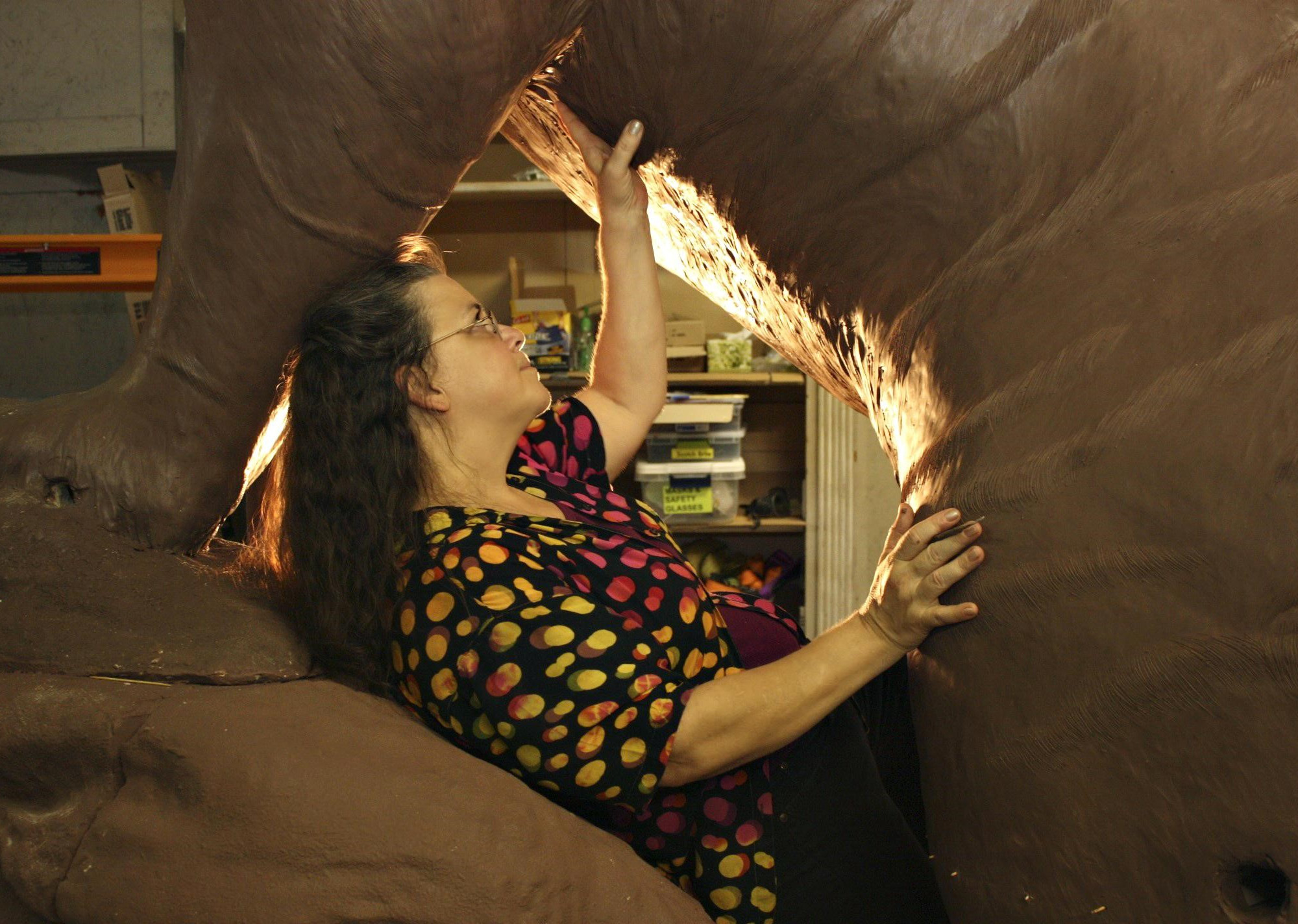
This article originates from Women In 3D Printing and is part of our effort to support the use of 3D printing technology by women. The article is re-published with permission.
Nora Toure: Bridgette, could you let us know about your background and what brought you to 3D printing?
Bridgette Mongeon: I am an American figurative sculptor of over 20+ years. With my art and my 3D technology journey, I have created quite a niche for myself. This was rather unintentional, but has proved to be very exciting. I am a fine artist and writer bridging the chasm between fine art and digital technology. It has been so strange to see these two worlds come together and even more strange to see my new book “3D Technology in Fine Art and Craft: Exploring 3D Printing, Scanning, Sculpting, and Milling” accepted into the libraries of fine art museums.
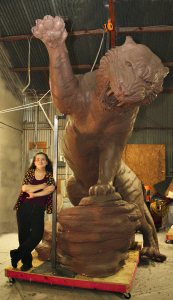
I have been interested in technology for quite some time. I was first introduced to 3D technology by my many trips to SIGGRAPH, “An international community of researchers, artists, developers, filmmakers, scientists, and business professionals who share an interest in computer graphics and interactive techniques.”
I began to write about mixing traditional and digital processes for Sculpture Review in 2007-2008. At the same time, I had returned to college for my Masters of Fine Arts degree that I developed around 3D technology in fine art.
Though I had been watching the progress of 3D printing for a while, it took some time for it to become affordable and for it to have the resolution that I would need in my own fine art workflow. Therefore, my first introduction to 3D technology was really in sculpting in Mudbox and ZBrush. I also did a lot of 3D scanning and used the subtractive process of CNC Milling (Computer Numerically Controlled). CNC is very similar to 3D printing; it uses STL files, g-code and creates in layers. It does it by a subtractive process instead of additive process. Of course, some technology does both 3D printing and CNC to create even finer detail. (If you are interested in taking a look, I have an example of CNC on my Morphing of a March Hare YouTube video. The process of creating the March Hare is described in the video, including 3D printing, but the CNC can be seen at the 2:00 mark on the video.) As it is with 3D printing, watching artwork emerge with CNC is also fascinating to see.)
In my book, I also mention that embracing the technology was also due, in part, to the fact that over years of sculpting I had injured myself and lost the use of my right arm. I have since had surgery and can work again. 3D printing was a natural transition for me in my workflow. The book documents my learning of transition from fine art to digital technology. It displays the work and process of 80 artists and vendors and a great deal of my learning through this journey of technology.
Nora Toure: What was your very first experience with 3D Printing?
Bridgette Mongeon: My first experience of 3D printing was seeing it at SIGGRAPH, and also inviting it into 3D CAMP Houston, of which I was the co-chair for a couple of years. Using 3D printing on my own came from having 3D files in my computer that I was enlarging. It was just as easy to 3D print them as it was to CNC mill them. I have used 3D printing quite often, since then and continue to find new ways of incorporating 3D printing into my traditional workflow.
Nora Toure: What inspires you to create?
Bridgette Mongeon: I’m very lucky to get paid to do what I love to do. I am a commissioned artist first, which means that people pay me for the work before it even gets into my studio. So, I guess my commissions and a paycheck inspires me. But there are also other things that inspire me. I love children, fanciful things, history and honoring the deceased. (I do a lot of commission portraits of deceased loved ones. More information here) I weave what I love into my commissions.
There are so many things that I would like to do that surround 3D printing, and I do hope to do some collaboration with different technologies. I try to incorporate most of my collaborations in 3D into my current projects. I love to weave them together and also help promote the vendors through the publicity that the project receives.
In my writing, I’m inspired by helping others. I also love to develop community, and I feel that sharing my experiences may help others to navigate on their own journeys. I have a marketing background and am working on a book about marketing, and a follow up book about 3D printing, scanning, sculpting and milling. No matter if it is writing or creating I am very inspired by helping others.
Nora Toure: Why use 3D printing for your creations?
Bridgette Mongeon: 3D printing helps me to offer more to my clients. For example, I created the 15-foot bronze Grambling Tiger for Grambling State University. I reduced the 3D file down to create a 3D print for casting in bronze or selling in the school’s bookstore. I have created other mascots, and the process of extending the life of the design to create more income for my studio by using 3D printing is exciting.
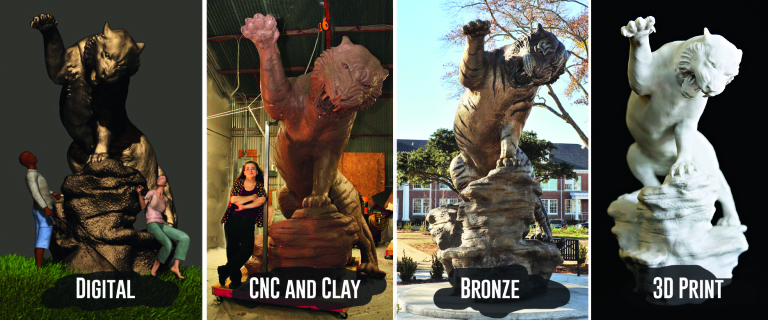
When I first started in 3D technology, it was pretty much male dominated. I tell people that I had to travel through many tutorials on monsters, aliens, and big, breasted women to obtain the skills that I needed in the software. Very few women were creating in the computer.
During that time of research, I also told everyone I met that I wanted to get the work out of the computer. Most everyone was doing CG work for movies or print. When making the statement of my need to get the work out of the computer people would question, “Why on earth would you want to do that?” For me, as a sculptor, if I can’t get it out of the computer it is useless.
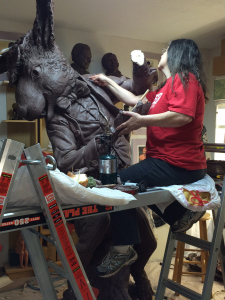
In my book, I have documented many ways that I, and other artist, have used digital technology in our fine art studios. I’m always looking for ways to push my limits and explore the combinations. My present project- the Alice in Wonderland sculpture titled “Move One Place On” is the most recent way. The project is a monumental sculpture of the Mad Hatter’s tea party. The characters are very large, with the Mad Hatter measuring 8 feet tall. There are five main characters, Alice in a chair, the Cheshire Cat, the Mad Hatter, March Hare and Dormouse. The scene also has an 8-foot table where visitors can bring their lunch and eat.
I go back and forth between digital and traditional in my workflow, and this project is a perfect example. With “Move One Place On,” I started with a digital sketch. I need to do these sketches quickly as I am trying to sell the project to the client. I created the original sketch using ZBrush, Mudbox, Photoshop, Daz and Poser. The sketch is specifically to give the client an idea of my intentions with a project.
Once I have sold the client on the idea, I move on to making the idea more my own. In the case of selling Alice and the sculpture, this “selling” of the idea took me three years. That is why it is important to have that first digital sketch done quickly with as little non-billable hours as possible.

After my digital sketches won the client over, and they signed the contract, I then sculpted small clay maquettes to work out my ideas. Some things I find I can do easier in traditional clay and others things I find easier to do digitally. I then scan the clay maquettes. I have a Next Engine Scanner in my studio, and that works perfectly for me. Though a representative from the University of Houston brought by their Artec scanner and scanned a piece for the Alice sculpture as well. Along with scanning, I also use photogrammetry.
Next, the digital design is further revised. For example, it is much easier to put a small cup, saucer, and watch in a digital design than it is to sculpt a tiny ½ inch cup. This entire digital design was then formatted for 3D printing and printed out at 3Drp in California. I originally just wanted to show the digital design at 3D Printing World Expo where I was speaking, but having the 3D print has been very valuable to us in the studio as reference as we enlarge the sculpture.
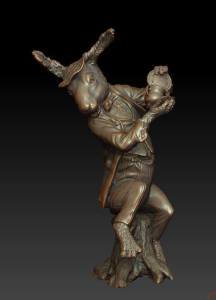
The clay maquettes are fragile and don’t handle the type of use that we put them through when using them as reference to make the large sculptures. I wish I had taken the time to make 3D prints of all of the figures, and will definitely make it a part of the workflow in my future.
I also send the digital files to Synappsys Digital Services in Oklahoma who CNC mills it out of foam at the desired large size.
The foam pieces are sent to me, and we put them together as seen in the Morphing of a March Hare YouTube video. There is still a ton of work to do. My interns and I carve the foam adding more detail. The CNC machine could give me further detail, but more time on the machine means more money. Plus, I have noticed that time and time again, designs that are created in the computer always need some tweaking, whether they are 3D printed or CNC Milled. So, we do that in my studio. (In the case of needing revisions with 3D printing, it may mean making revisions in the computer and then printing out a second, third or even fourth print.) We also add clay to the foam, and in that clay, we put even more detail.
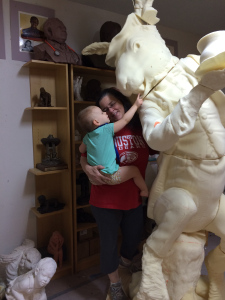
Once the client approves the piece, we will make a mold of the sculpture before sending it to Shidoni Foundry in New Mexico. It is a long process that takes months. The contract for “Move One Place On” was signed in July of 2015. We hope the sculpture will be ready to install in Evelyn’s Park in Bellaire, Texas, just outside of Houston at the end of 2016. This is a very, very quick turnaround for such a large project. It is only made possible through the incredible technology, and, I might add, the dedication of my incredible interns in my studio. So, the technology helps me to work faster, and therefore, I can bring in more income to my studio.

The other interesting aspect of this wonderful project with Alice and her friends is that I am hiding 150 elements of the story in the large scene. This is in honor of the 150th anniversary of “Alice’s Adventures in Wonderland” which is celebrated this year. I talk about the hidden elements in the Mad Tea Party Sculpture Project video on YouTube. Many of these hidden pieces are going to be designed in the computer, then they will be 3D printed and added to the clay sculpture before I make a mold for bronze casting.
You can follow along with the process on the Finding Alice Facebook page. We are presently winding down on the creation of the main characters, and I expect to be creating many of these 3D printed pieces in the next month. I can hardly wait.
When the sculpture is complete, Smart Geometrics, who scans for architectural and historical preservations will be coming into the studio to scan the entire sculpture. Then the scene, with all of the characters and detail, will be reduced down and 3D printed for bronze casting.
After I complete the project, I also plan on making some of the hidden items into other various trinkets and goodies for sale. That should be fun, and I sure hope I have time to work on these as I’m already planning the next commission, a Neil Armstrong sculpture for Russian. I’m also writing a book similar to 3D Technology in Fine Art and Craft, but this one is about the art and technology in the Alice Project.
Nora Toure: What do you think of the 3D Printing industry today?
Bridgette Mongeon: People always ask me if I own a 3D printer. I do not. One person on a 3D printing forum asked me how I could write about 3D printing if I did not own one. I replied, “I write about bronze casting and don’t own a foundry.” There are many options to owning a 3D printer such as using local service providers, service bureaus, and using maker spaces.
3D printers are temperamental. 3D printing is not done at a push of a button, and I would rather pay a vendor to fool with it than take away time from my creating. Though I do have a hunger to print in wood, and I find the idea of having a clay printer absolutely yummy and the thought makes me salivate creatively. It is interesting that I really gravitate to material that I can fool with after the print is done. I’m also watching the progress of Carbon 3D as I like the idea of the fast and high-resolution prints. So, my not having a 3D printer may change in the very near future, but even in my lusting we are talking about three different types of 3D printers and processes. I’m sure if I had a printer, I might experiment a bit more and that would be fun. So if anyone wants to send a printer for review, give me a call, meanwhile I work with a variety of vendors so that they can benefit from the promotion from the high profile projects that I am working on.
Build envelope, size, materials, resolution and cost. These are things I talk about a lot in my book. It is interesting, with all of my experimentation and resources, when I do research for a new project and think about using digital technology I usually end up coming back to the traditional process of creating because it is less expensive or holds more detail. I look forward to the day when we can 3D print large things, inexpensively, with good resolution at a reasonable price in a variety of materials. I can dream.
I’m especially interested in seeing the advances and changes in the lost wax method of bronze casting. I have seen the digital technology infiltrate this age-old process and have dedicated an entire chapter in the book titled “Foundry of the Future.” Seeing how 3D printing is entering this arena excites me.
There are still huge gaps in the ease of the process of creating things for 3D printing. I have seen this change over the years, but once the bottleneck of the creative process—from idea to physical print is made more fluid, I think it will be more accessible and desirable for many. I wrote my book to help individuals navigate that bottleneck.
Nora Toure: In your opinion, how could we encourage more women to become involved with 3D Printing?
Bridgette Mongeon: I’m very excited about encouraging woman and girls to enter the digital world and technology in general. I do this in several ways. I am as much inspired by helping others and creating community as I am inspired by creating sculpture or writing. Helping and passing on information is an obsession.
I have been delighted to be a part of Expanding Your Horizons in Math and Science created by American Association of University Women in Houston, Texas for the last few years. We introduce girls as young as 12 and 13 to digital technologies, and all of the possibilities. One year I created an online video with Coco, an amazing 12-year-old that I met at 3D Printing World Expo. The video is called “Don’t Wait to Grow Up, Be a Tech Girl Now.” (Coco’s interview about her 3D printer is at 1:40 on the video.) The girls loved the inspiration. Each year we do a hands-on activity, the first year we did a group scan using Autodesk’s free photogrammetry program 123D CATCH. This past year we learned about polygons and geometry of 3D and created a Decahedron. I love to share curriculum ideas for incorporating STEAM and hope that I can find more time to create curriculum and share it in a community in the future.
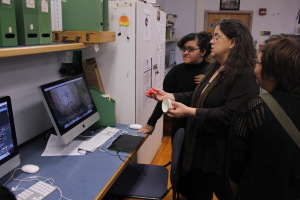
Recently I went to my hometown and spoke at my high school. That was a surreal experience. I invited the school to participate in the Alice project. I scanned my mother’s antique teacups and sent the STL files to the school. The kids were asked to “enhance” the teacups to bring out the delicate paintings into 3D using Mudbox. The cups will be 3D printed and placed in the scene before making a mold and going to bronze. How delighted I was that three young women stepped up to the challenge of creating a cup. I’ll have to let you know how that progresses. I believe it is very important to encourage women and young girls in exploring and opportunities of 3D Technology.
As I said, creating community is an obsession of mine and to keep the dialogue going I created an Art and Technology Podcast. I love interviewing others about their process and journey. You can find them on the book’s website http://digitalsculpting.net/ and on ITunes. I look forward to podcasting with more women working with 3D technology. Creating a book and podcasts is great to present information, but I felt it was necessary to have resources where others could go to ask questions or post their work, so I put together the 3D Technology Facebook and LinkedIn Pages.
The way to encourage 3D printing with other women is to spread the word. 3D printing is so diversified and cross-disciplinary. That means there are many opportunities to present information. If you are not talking about it, then find opportunities for others to talk about it and share. This can be done by inviting guest speakers to events, sharing articles through social media, and creating networking opportunities. Who knows what we will create and what digital boundaries we women can push by helping each other spread the word.
You can follow Bridgette on Twitter and through her website. Please see the links below to follow our current projects: Finding Alice – Creative Endeavors – 3D technology in Fine Art and Craft
And don’t forget to join the Women in 3D Printing group on LinkedIn and Facebook
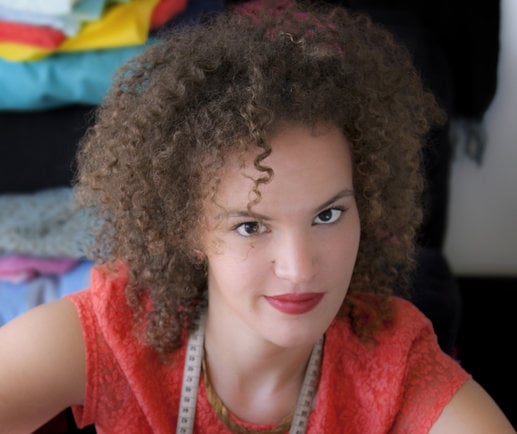
California-based Nora Toure is the woman behind “Women in 3D Printing”, a group dedicated to promoting and showcasing the use of 3D printing for women. She’s also a Sales Manager at 3D print -on-demand service Sculpteo.

